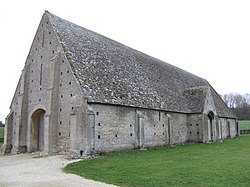Great Coxwell: Difference between revisions
Created page with '{{Infobox town |name=Great Coxwell |county=Berkshire |picture=Great Coxwell Barn - geograph.org.uk - 307442.jpg |picture caption=The Tythe Barn |os grid ref=SU270935 |latitude=51…' |
|||
| (One intermediate revision by the same user not shown) | |||
| Line 15: | Line 15: | ||
|constituency=Wantage | |constituency=Wantage | ||
}} | }} | ||
'''Great Coxwell''' is a village in [[Berkshire]] | '''Great Coxwell''' is a village in [[Berkshire]] two miles southwest of [[Faringdon]] close by the [[Wiltshire]] border. | ||
The village lies on the Corallian limestone beds on the northern slope of the [[Vale of White Horse]]. | The village lies on the Corallian limestone beds on the northern slope of the [[Vale of White Horse]]. | ||
| Line 25: | Line 25: | ||
The Church of England parish church of Saint Giles stands in prominently on a ridge at the south end of the village.<ref>[http://www.berkshirehistory.com/churches/great_coxwell.html Royal Berkshire History website]</ref> Parts of the church date date from about 1200.<ref>Pevsner, 1966, page 147</ref> The west tower was added in the 15th century.<ref name=Page>Page & Ditchfield, 1924, pages 487-489</ref> | The Church of England parish church of Saint Giles stands in prominently on a ridge at the south end of the village.<ref>[http://www.berkshirehistory.com/churches/great_coxwell.html Royal Berkshire History website]</ref> Parts of the church date date from about 1200.<ref>Pevsner, 1966, page 147</ref> The west tower was added in the 15th century.<ref name=Page>Page & Ditchfield, 1924, pages 487-489</ref> | ||
The tower has a ring of five bells.<ref name=Page/> Three were cast in 1738: two including the tenor bell by Henry Bagley of [[Chacombe]].<ref name=Page/> Another was cast by James Wells | The tower has a ring of five bells.<ref name=Page/> Three were cast in 1738: two including the tenor bell by Henry Bagley of [[Chacombe]].<ref name=Page/> Another was cast by James Wells of [[Aldbourne]] in 1824, and the tenor bell was cast by Mears and Stainbank in 1911.<ref name=Page/> The bells are currently unringable.<ref>[http://www.vowh.org.uk/vowh/towers.aspx Vale of the White Horse Branch: Oxford Diocesan Guild of Church Bell Ringers: Branch Towers]</ref> | ||
The churchyard is now managed as a wildlife area. It contains over 100 species of wildflower, including the rare wild clary (''Salvia verbenacea'').<ref>[http://www.faringdon.org/hystgilesch.htm Faringdon on line: St Giles Church, Great Coxwell]</ref> | |||
==Great Coxwell Barn== | ==Great Coxwell Barn== | ||
On the northern edge of the village is a large 14th century tithe barn, built for Beaulieu Abbey to store the crop of its monastic grange. The barn is now in the care of the [[National Trust for Places of Historic Interest or Natural Beauty|National Trust]]. | On the northern edge of the village is a large 14th century tithe barn, built for Beaulieu Abbey to store the crop of its monastic grange. The barn is now in the care of the [[National Trust for Places of Historic Interest or Natural Beauty|National Trust]]. | ||
Latest revision as of 17:50, 5 August 2014
| Great Coxwell | |
| Berkshire | |
|---|---|
 The Tythe Barn | |
| Location | |
| Grid reference: | SU270935 |
| Location: | 51°38’20"N, 1°36’29"W |
| Data | |
| Population: | 274 (2001) |
| Post town: | Faringdon |
| Postcode: | SN7 |
| Dialling code: | 01367 |
| Local Government | |
| Council: | Vale of White Horse |
| Parliamentary constituency: |
Wantage |
Great Coxwell is a village in Berkshire two miles southwest of Faringdon close by the Wiltshire border.
The village lies on the Corallian limestone beds on the northern slope of the Vale of White Horse.
History
The Domesday Book of 1086 records the village as belonging to Earl Harold (King Harold II) before the Norman Conquest of England. In 1205 the manor was granted to Beaulieu Abbey, which held it until the Dissolution of the Monasteries. In 1540 the manor was bought by Thomas Morris, whose descendants sold it in 1638 to the Pratt family.
Church
The Church of England parish church of Saint Giles stands in prominently on a ridge at the south end of the village.[1] Parts of the church date date from about 1200.[2] The west tower was added in the 15th century.[3]
The tower has a ring of five bells.[3] Three were cast in 1738: two including the tenor bell by Henry Bagley of Chacombe.[3] Another was cast by James Wells of Aldbourne in 1824, and the tenor bell was cast by Mears and Stainbank in 1911.[3] The bells are currently unringable.[4]
The churchyard is now managed as a wildlife area. It contains over 100 species of wildflower, including the rare wild clary (Salvia verbenacea).[5]
Great Coxwell Barn
On the northern edge of the village is a large 14th century tithe barn, built for Beaulieu Abbey to store the crop of its monastic grange. The barn is now in the care of the National Trust.
Badbury Hill
Badbury Hill is in the north of the parish. There is an Iron Age hill fort on its summit, and there is ancient woodland on its slopes. The hill is in the care of the National Trust.
Outside links
| ("Wikimedia Commons" has material about Great Coxwell) |
References
- ↑ Royal Berkshire History website
- ↑ Pevsner, 1966, page 147
- ↑ 3.0 3.1 3.2 3.3 Page & Ditchfield, 1924, pages 487-489
- ↑ Vale of the White Horse Branch: Oxford Diocesan Guild of Church Bell Ringers: Branch Towers
- ↑ Faringdon on line: St Giles Church, Great Coxwell
Sources
- Page, W.H.; Ditchfield, P.H., eds (1924). A History of the County of Berkshire, Volume 4. Victoria County History. pp. 487–489. http://www.british-history.ac.uk/report.aspx?compid=62755.
- Pevsner, Nikolaus (1966). Berkshire. The Buildings of England. Harmondsworth: Penguin Books. pp. 147–148.
